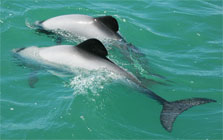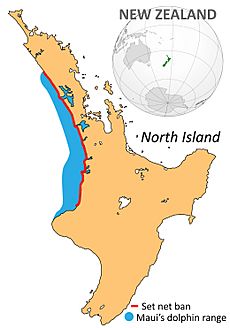Māui dolphin facts for kids
Quick facts for kids Māui dolphin |
|
|---|---|
 |
|
| Conservation status | |
| Scientific classification |
|
| Kingdom: | Animalia |
| Phylum: | Chordata |
| Class: | Mammalia |
| Order: | Artiodactyla |
| Infraorder: | Cetacea |
| Family: | Delphinidae |
| Genus: | Cephalorhynchus |
| Species: | |
| Subspecies: |
C. h. maui
|
| Trinomial name | |
| Cephalorhynchus hectori maui Baker et al., 2002
|
|
The Māui dolphin or popoto (Cephalorhynchus hectori maui) is a special type of Hector's dolphin. It is New Zealand's only native dolphin species. Māui dolphins live only off the west coast of New Zealand's North Island. They are one of the rarest and smallest dolphin types in the world.
Experts believe there are only about 63 Māui dolphins left. Both Māui dolphins and their relatives, the South Island Hector's dolphins, face dangers. These dangers include fishing nets and diseases. Not having enough food might also be a problem for Māui dolphins. This could make them more sensitive to climate change.
Contents
What's in a Name?
The name "Māui" comes from Te Ika-a-Māui. This is the Māori name for New Zealand's North Island. However, the Māori word for the dolphin itself is popoto.
In English, people used to spell it "Maui's dolphin." Now, the New Zealand Department of Conservation prefers "Māui dolphin." This spelling uses a macron over the 'a'.
How Māui Dolphins Are Unique
In 2002, scientists decided Māui dolphins were a special type of Cephalorhynchus hectori. Before that, they were called the North Island Hector's dolphin. A scientist named Alan Baker found differences in their genes and bones. These differences made them unique from South Island Hector's dolphins.
It was once thought that Hector's dolphins could not swim to the North Island. The deep water between the islands seemed to be a barrier. However, some Hector's dolphins have been found in the Māui dolphin's area.
Scientists are not sure if Hector's and Māui dolphins breed together. They are very similar genetically, so it is possible. If they did, it might increase the number of dolphins. But it could also make the Māui dolphin lose its unique identity. This mixing could cause problems for the Māui dolphin in the long run.
Physical Description and Life Cycle
Māui dolphins look very much like South Island Hector's dolphins. You can tell them apart from other dolphins by their unique features. They have grey, white, and black markings. They also have a short snout and a special rounded dorsal fin. Hector's dolphins are the smallest dolphin species in the world.
Female Māui dolphins can grow up to 1.7 meters long. They can weigh up to 50 kilograms. Males are usually a bit smaller and lighter.
Māui dolphins likely live a similar life to Hector's dolphins. Hector's dolphins can live for at least 22 years. They start having babies around six to eight years old. They usually have one calf every two to four years. We still have much to learn about Māui dolphin reproduction.
Ecology and Behavior
Habitat, Diet, and Predators
Māui dolphins prefer coastal waters that are a bit cloudy. They spend a lot of time diving to find fish on the sea floor. They also look for food in the middle of the water and near the surface. We do not know much about what Māui dolphins eat. We know they eat fish like ahuru, red codling, and flatfish.
Large sharks are known predators of both Hector's and Māui dolphins. These include the broadnose sevengill shark, great white shark, and blue shark.
Vocalizations and Echolocation
Māui dolphins use echolocation to move around and find food. They send out high-frequency clicks. These clicks bounce off objects in the water and return to the dolphin. This helps them "see" their surroundings. This is different from many other dolphins that use whistles to communicate.
Social Behavior
Māui dolphins have been seen playing. They play with seaweed, chase each other, and blow bubbles. They also engage in play fighting.
Population and Where They Live
There are only about 63 Māui dolphins left that are one year or older. This number comes from genetic studies. Because their population is so small, Māui dolphins are listed as Critically Endangered. The Department of Conservation also calls them "Nationally Critical."
Māui dolphins live only off the west coast of New Zealand's North Island. They usually stay close to shore in small groups. They are often seen in water shallower than 20 meters. Their current home range is from Maunganui Bluff in the north to Whanganui in the south. Some Māui dolphins have been found further south, near Wellington Harbour.
Surveys have been done to find Māui dolphins. In 2012 and 2013, many searches were done between New Plymouth and Hāwera. No Māui or Hector's dolphins were seen during these searches.
Threats to Māui Dolphins
Fishing
Māui dolphins can get caught and drown in fishing nets. This includes nets used by commercial fishing boats and recreational nets. Set nets are thought to be the biggest danger from commercial fishing.
Since 2003, when fishing rules were put in place, 15 Māui or Hector's dolphins have died. Most of these deaths were from disease or natural causes. Only one death was linked to fishing. This dolphin was caught in a set net in 2012.
In 2019, a study estimated that very few Māui dolphins die in commercial nets each year. This number is much lower than earlier estimates. Earlier, experts thought about five Māui dolphins died each year from fishing.
Fishing Restrictions
Rules have been put in place to protect Māui dolphins. In 2003, a ban on commercial set nets was added. This ban covered an area from Maunganui Bluff to Pariokariwa Point. It extended out to four nautical miles from shore. Recreational set netting was already banned there.
In 2008, the set net ban was extended to seven nautical miles from shore. The ban on trawling was also extended. In 2013, the protected area was made even larger. It now goes around the Taranaki coast to Hāwera. Set netting is banned out to two nautical miles there. Between two and seven nautical miles, it is only allowed with government observers.
Set netting is also banned inside the entrances of some harbors. These include Kaipara, Manukau, and Raglan Harbours.
Some groups, like the World Wildlife Fund, want more fishing bans. They want a full fishing ban over the entire Māui dolphin range. The International Whaling Commission also supports more restrictions. However, the New Zealand government has been hesitant. Some in the fishing industry are against more bans. They say other things, like disease or pollution, are the real problems.
Oil and Gas Operations
In 2014, the government allowed oil drilling in part of the Māui dolphin's main home. This area is called the West Coast North Island Marine Mammal Sanctuary. About a quarter of this sanctuary was opened for drilling.
Food and Climate Change
Māui dolphins live in the warmest part of the Hector's dolphin's range. This means they might be very sensitive to warming oceans. Studies show that Māui dolphins have much less food available than Hector's dolphins. Not having enough food could make them even more at risk from climate change.




